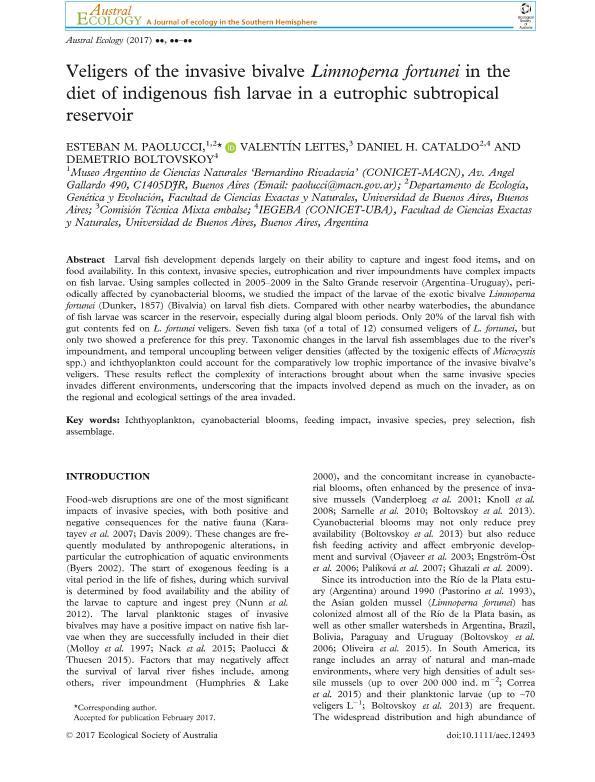Artículo
Veligers of the invasive bivalve Limnoperna fortunei in the diet of indigenous fish larvae in a eutrophic subtropical reservoir
Fecha de publicación:
11/2017
Editorial:
Wiley Blackwell Publishing, Inc
Revista:
Austral Ecology
ISSN:
1442-9985
Idioma:
Inglés
Tipo de recurso:
Artículo publicado
Clasificación temática:
Resumen
Larval fish development depends largely on their ability to capture and ingest food items, and on food availability. In this context, invasive species, eutrophication and river impoundments have complex impacts on fish larvae. Using samples collected in 2005–2009 in the Salto Grande reservoir (Argentina–Uruguay), periodically affected by cyanobacterial blooms, we studied the impact of the larvae of the exotic bivalve Limnoperna fortunei (Dunker, 1857) (Bivalvia) on larval fish diets. Compared with other nearby waterbodies, the abundance of fish larvae was scarcer in the reservoir, especially during algal bloom periods. Only 20% of the larval fish with gut contents fed on L. fortunei veligers. Seven fish taxa (of a total of 12) consumed veligers of L. fortunei, but only two showed a preference for this prey. Taxonomic changes in the larval fish assemblages due to the river's impoundment, and temporal uncoupling between veliger densities (affected by the toxigenic effects of Microcystis spp.) and ichthyoplankton could account for the comparatively low trophic importance of the invasive bivalve's veligers. These results reflect the complexity of interactions brought about when the same invasive species invades different environments, underscoring that the impacts involved depend as much on the invader, as on the regional and ecological settings of the area invaded.
Archivos asociados
Licencia
Identificadores
Colecciones
Articulos(IEGEBA)
Articulos de INSTITUTO DE ECOLOGIA, GENETICA Y EVOLUCION DE BS. AS
Articulos de INSTITUTO DE ECOLOGIA, GENETICA Y EVOLUCION DE BS. AS
Citación
Paolucci, Esteban Marcelo; Leites, Valentín; Cataldo, Daniel Hugo; Boltovskoy, Demetrio; Veligers of the invasive bivalve Limnoperna fortunei in the diet of indigenous fish larvae in a eutrophic subtropical reservoir; Wiley Blackwell Publishing, Inc; Austral Ecology; 42; 7; 11-2017; 759-771
Compartir
Altmétricas




